“SRI VIJAYEENDRA TIRTHARU
श्री विजयींद्रतीर्थरु
ಶ್ರೀ ವಿಜಯೀಂದ್ರತೀರ್ಥರು
ಶ್ರೀ ವಿಜಯೀಂದ್ರ ತೀರ್ಥರ ಚರಮಶ್ಲೋಕ
भक्तानां मानसांभोजभानवे कामधेनवे । नमतां कल्पतरवे जयींद्रगुरवे नम: । ಭಕ್ತಾನಾಂ ಮಾನಸಾಂಭೋಜಭಾನವೇ ಕಾಮಧೇನವೇ | ನಮತಾಂ ಕಲ್ಪತರವೇ ಜಯೀಂದ್ರಗುರವೇ ನಮ: | ಭಕ್ತರ ಮನಸ್ಸೆಂಬ ಕಮಲಗಳನ್ನು ಅರಳಿಸುವ ಸೂರ್ಯ ನಂತಿರುವ, ನಮಿಸುವವರಿಗೆ ಕಲ್ಪವೃಕ್ಷವೂ, ಕಾಮಧೇನುವೂ ಆದ ವಿಜಯೀಂದ್ರ ಗುರುಗಳಿಗೆ ನಮಸ್ಕಾರ..ಚಾತುರ್ಯೈಕಾಕೃತಿರ್ಯ: ಚತುರಧಿಕಶತಗ್ರಂಥರತ್ನಪ್ರಣೇತಾ
ಧೂತಾರಾತಿಪ್ರಬಂಧ: ಸ್ಫುಟವಿದಿತಚತು:ಷಷ್ಟಿವಿದ್ಯಾವಿಶೇಷ: |
ಸೋಽಯಂ ನ: ಶ್ರೀ ಸುರೇಂದ್ರವ್ರತಿವರತನಯೋಽ ದ್ವೈತಶೈವಾಸಹಿಷ್ಣು:ಪುಷ್ಣಾತು ಶ್ರೀಜಯೀಂದ್ರ:
ತ್ರಿಭುವನವಿದಿತ: ಸರ್ವತಂತ್ರಸ್ವತಂತ್ರ: ||
ಶ್ರೀವಾದೀಂದ್ರತೀರ್ಥಕೃತ “ಗುರುಗುಣಸ್ತವನ”
ಸ ಜಯತಿ ಯತಿಚಂದ್ರ:ಸಹಿತೇ ಶಾಸ್ತ್ರಸಾಂದ್ರ:
ಸತತಗಲಿತತಂದ್ರ: ಸದೃಶಾ ಶ್ರೀ ಜಯೀಂದ್ರ: |
ಜಹಿ ಹಿ ನಿಜಜಯಾಶಾ ಜಾಗ್ರದಾಯಾಸಲೇಶಾ- ಜ್ಜಡಯದಧಿನಿದೇಶಾಜ್ಜಾತಹರ್ಷಾದ್ರಿಗೀಶಾ: ||
– ShrI Sudheendra Tirtharu
ಪದವಾಕ್ಯ ಪ್ರಮಾಣಜ್ಞಾನ ಸೌಶೀಲ್ಯಾದ್ಯುಪಸೇವಿತಂ | ವಿಜಯೀಂದ್ರಯತಿದ್ವಾಖ್ಯಾನ್ ಸೇವೇ ವಿದ್ಯಾಗುರೂನ್ ಮಮ – Sri Kambalur Ramachandra Tirtharu
ಸ್ವದರ್ಶಣೋಕ್ತದೂಷಣಂ ನಿರಾಕರಿಷ್ಣುರಂಜಸಾ | ಜಯೀಂದ್ರಯೋಗಿರೂಪತೋಽವತೀರ್ಣ ಏಷ ಪೂರ್ಣಧ – Sri Appayya Deekshitaru after being defeated
ಶ್ರೀ ವಿಜಯೇಂದ್ರ ತೀರ್ಥರಿಗೆ ಮೂರೂ ಹೆಸರುಗಳು “ವಿ” ಕಾರದಿಂದ ಆರಂಭವಾಗತ್ತೆ.
ಜನ್ಮನಾಮ – ವಿಠಲಾಚಾರ್ಯರು
ಆಶ್ರಮ ನಾಮ – ವಿಷ್ಣು ತೀರ್ಥರು
ದಂಡ ಬದಲಾವಣೆ ನಾಮ – ವಿಜಯೇಂದ್ರ ತೀರ್ಥರು
“V” for Vijayeendraru
1. Birth Name – Vitalacharyaru
2. Ashrama Name – Vishnu Tirtharu
3. Danda Changed Name – Vijayeendra Tirtharu
Vijayeendraru @ Nanganallur Rayara Mutt, Chennai
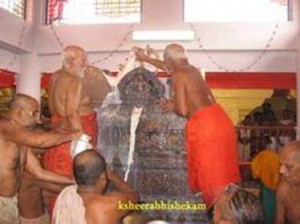
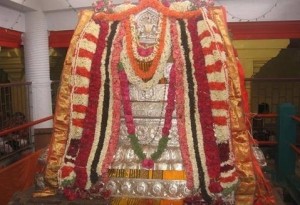
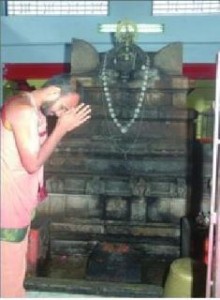
Sri Vijayeendra Tirthara Mruttika Vrundavana at :
1. Holagunda in Alur Taluk, Karnool District
2. Nanganallur Rayara Matha, Chennai
- Vijayendrara Granthagalu (Kannada, Sanskrit) – CLICK
- Vijayendraru (ENGLISH) – click
- Vijayendra Tirtharu – Life History – click
- Vijayendraru (Miracles) – click
- Vijayendrara Grantha – Aadyanta Shloka (kannada) – click
- Vijayendrara Grantha – Aadyanta Shloka (SANSKRIT) – click
- Sarva Siddantha Saarasara Vivechanam by Vijayeendraru – click
- Vijayendra Stotra (KANNADA) – click
- Vijayendra Stotra (TAMIL, TELUGU, MALAYALAM) – click
- Devaranamagalu on VIJAYENDRARU – click
- Paapa vimochana stotra with meaning in Kannada – click
- Paapa Vimochana Stotra –in Tamil, Telugu lipi – click
- Paapa vimochana stotra in Devanagiri – click
- narasimhastakam – kannada – click
- narasimhastakam – sanskrit – click
| Period | 1517 – 1614 |
| Birth Name | Vittalacharya |
| Ashrama Name | Vishnu Tirtha |
| Ashrama taken | 1525-26 |
| Ashrama Given by | Sri Vyasarajaru |
| Vidya Gurugalu | Sri Vyasarajaru |
| “Danda” changed to whom? | Sri Surendra Tirtharu 1530AD |
| Successor | Sudheendra Tirtharu |
| Vrundavana | Kumbakona |
| Aradhana Day | Jyesta Krishna Trayodashi |
| Maha Samsthanadhipatya | 1575-1614AD |
| Vidyapeeta Started | 1550AD @ Kumbakona |
| Vidya Shishyas | Sudheendraru,Kambaluru Ramachandra Tirtharu |
| Contemporaries | Purandaradasaru, Vyasarajaru, etc |
| Maximum time spent in | Kumbakona |
| Rathnabhisheka | By Ramaraja of Vijayanagar |
| Ankita | Vijayeendra Raama |
(Note – Regarding Vijayeendra Tirtha’s birth date, ashrama date, Samsthanadhipatya dates, etc – there is different versions from different authors, like BNK Sharma, HK Vedavyasachar, Bheemacharya Vadavi.,)
Sri Vijayeendra Tirtharu saved Madhva Siddhanta from a very real and serious threat of extinction in South India, during the 16th century. Hence the followers of Madhva Siddhanta should always remain grateful to the memory of Sri Vijayeendra Teertharu’s great personality. He was a master of all arts. He was master in all 64 vidyas. That is why he was called as “Chatu:Shasti Vidya Praveena”. When Appayya Deekshitaru, a renowned Advaita Vidwan, challenged about Madhwa Shastra, Sri Vijayeendraru single handedly, defeated him in all sets of arguments which run into many many years and finally Appayya Deekshitaru accepted his defeat.- Birth of Vijayeendraru – When an old couple approached Sri Vyasarajaru, he blessed them that they shall have two children. Even the old couple themselves were shocked to hear that they are going to get a child at their old age. After some time the old couple had two children, whom they named as “Vittalacharya” and “Guruprasada”.
- Vittalacharya became Vishnu Tirtha – Sri Vyasarajaru arranged for the “Choula” and “Upanayanam” for Vittalacharya. He also taught him “Tarka, meemaamsa, Vedanta Shastra”. At the age of 8, when Sri Vyasarajaru was satisfied with the Vairagya of the child gave him Sanyasashrama and named him as “Vishnu Thirtha”
- Vishnu Tirtha became Vijayeendra Tirtha – Sri Surendra Tirtharu was a saint from Sri Vibudendra Tirtha Mutt (Earlier Rayara mutt was called as Vibudendra Tirtha Mutt only, before rayaru). Sri Surendra Tirtharu was looking for his successor. Once he had the opportunity of visiting Sri Vyasarajaru and there he saw Vishnu Tirtha. He asked Vyasarajaru to gift Vishnu Tirtha, which Vyasarajaru readily agreed and gave him to Surendra Tirtha. Sri Surendra Tirtha was extremely happy to get Sri Vishnu Tirtha as his disciple and made him sit on the throne of Srimad Acharya succeeded previously by Sri Vibudhendra Tirtha. Sri Surendra Tirtha renamed Sri Vishnu Tirtha as Sri Vijayeendra Tirtha and made him the emperor of the Vedanta empire.
- Victory in 64 vidya – Vijayeendra Tirtharu was well versed in 64 Vidyaas – Chatu: Shasti Vidya, and he had his victory against all his opponents in all fields. That is why he is called as “AjEya” (Never Defeated). Sri Vijayeendra Teertharu saved Madhva Siddhanta from a very real and serious threat of extinction in South India, during the 16th century. Hence the followers of Madhva Siddhanta should always remain grateful to the memory of Sri Vijayeendra Teertharu’s great personality. He was a master of all arts. He was master in all 64 vidyas. That is why he was called as “Chatu:Shasti Vidya Praveena”.
- Rajaashraya – As per Mysore Archealogical Report, he had received “daana” of land in 1580AD. Agnitrayaas – i) Sri Vijayeendraru; ii) Sri Tatacharya of Srivaishnava, iii) Appayya Deekshita of Advaita, the three were called as “agnitraya” and were in Sheshappanayaka’s palace.
He was having the knowledge of all the 64 vidyas, viz.,
- Music – Singing
- Music – Instrument – Flute
- Dance – Nartana
- Alekhya – Drawing
- VishEshaka ChEdyam – Tilaka rachane
- Drawing Padmakruti in front of pooja hall in Coloured rice and flowers
- PushpastaraNa – Spreading flowers in a beautiful way
- Vastralankara
- Manibhoomika karma – Designing with valuable jewels and pearls
- Shayana Rachanam – Alankara of bed
- Udakavaadya – Jalataranga Instrument
- UdaakaaGaata – JalataaDana art
- Chitrayoga – An yoga which makes our Indriyas inactive
- Maalyagrathanakalpaa – creating Different flower maalika
- SheKarakaapIDayOjanam – Alankara of hair in head
- Nepatya prayoga – Disguise Dressing
- Karnapatrabhanga – Making ornaments on ears
- Gandha yukti: – sugandha dravya rachana
- Bhooshana yojana – Ornaments arranging and wearing
- Aindrajala- kuchumaarayoga – Aindrajala vidya & rectifying loss in the body
- Hastalaghava – kaichalaka – Handworks
- Vichitra shaakayoosha bhakshya vikaraka kriya – Preparing different bhakshya, bhojya
- Paanakarasaraagaasavayojana – preparing paanaka, etc juice
- Soocheevaanakarma – Tailoring
- SootrakreeDa – Thread game
- VeeNa, Damaruka vaadya – playing Veena, Damaruka, etc
- Prahelika – Puzzling
- Pratimaala – i.e., antakshari game
- Durvaachaka yoga – using harsh (difficult) words for arguments and for fun
- Pustaka Vaachanam – Reading books based on respective “rasa prayoga”
- NaTakaaKyaayikaa darshanam – Telling the situation through abhinaya (acting)
- KaavyasamasyaapooraNam – When given a particular part of a shloka (one paada) – preparing the shloka to give full shlokabhipraya
- PaTTikaavEtravaana vikalpa – preparing Vessel, cloth, weaving, etc
- Takshakarmaani – Carpentry work
- TakshaNam – toy making
- Vaastuvidya – house construction
- Roopyaratna pareeksha – Examining Silver and other ornaments
- Dhaatuvaada – Examining stones, pearls, soil, etc
- MaNiraagaakaara Jnaana – identifying pearl’s different colours, group.
- Vrukshayurvedayoga – Preparing medicine from medicinal plants
- Mesha, Kukkuta, Laavakayuddavidhi – learning animal-birds systems
- Shukashaarikapralapanam – birds language
- Keshamardana, nerve improvement, health
- Akshara mushtikaa kathanam – Telling Secret news through finger vinyasa
- Mlenchitavikalpaa – Telling Secret news through secret words
- Deshabhaasha vijnaana – Different regional languages
- PuShpashakaTika – Preparing different items from flowers
- Nimitta jnaanam – Shakuna parichaya
- Yantramaatrukaa jnaanam – machine related
- Dharanamatruka – Ashtavadhana, shatavadhana vidya
- SampaaTyam – reading
- Maanasee – Locating item which is invisible through mind
- Kaavyakriya – Shrungaara kavya rachana
- Abhidhana kosha – Well versed in Dictionary, Ekakshara kosha, medina, etc
- ChandojNnanam – Chandassu in chandashastra
- Kriyakalpa – Knowledge of Planning
- Chalitakayogaa: – Winning capacity in Gambling through deceiving or confusing
- Vastragopanani – Protection of cloths from insects
- Dyotavisheshaa – Knowledge of Different Gambling games
- Attractive sports – stambheekarana, vasheekarana, goohana, akarshana,
- Balakreedanakaani – Knowledge of children plays
- Vaijayikeenaam vidya – Winning over opponents in any situation
- Vyaayamikinaam cha vidyaanaam vijnanam – Yogasana shastra
- Vainayikeenam vidya – Teaching of good behaviour
Miracles/Victories by Vijayeendra Tirtharu :-
Once Sri Vijayeendra Tirtharu challenged every one that any body can test him over his knowledge of 64 Vidya. He was well versed in all 64 Vidyaas. On his open challenge, many people tried to defeat and establish their supremacy over him, but none could succeed. Here are some of the instances wherein he mastered over his Vidya
-
Defeat of Krishna Sharma – Soon after his naming as successor for Surendra Tirtharu, he had a long debate with Sri Krishna Sharma, a great pandit, whom he defeated based on “Bhedha” tatva.
- Mantrika Vidya – He defeated a Malayaalee Mantrika in Mantrika Vidya
-
Kama Shastra – When some Brahmins tried to test him over Indriya Nigraha, by sending some beautiful girls, who did the massage on him, nothing could be changed in him. He was just chanting “Naarayana Mantra” throughout and nothing they could done to him.
- Appayya Deekshita – When Appayya Deekshitaru, a renowned Advaita Vidwan, challenged and wrote several granthas condemning Madhwa Shastra, like “Madhwatantra Mukhabanga”, “Shivatattvaviveka” – Vijayeendra Tirtha condemned them by his granthas, “Madhwa tantra mukhabhooshanam” or “Madhwadwa Kantakoddara”, “Appayya Kapola Chapetika”, “Paratatva Prakashika”, etc. Sri Vijayeendra Tirtha singlehandedly, defeated him in all sets of arguments which run into many many years and finally Appayya Deekshitaru accepted his defeat.
- Defeat of Lingarajendra – Shaivas used to forceably convert Vaishnavaas to Shaiva. Vijayeendra Tirtharu wanted to put an end to it. So, he came to Kumbakona and sat for vagvada with Shaiva pandita Lingarajendra with a condition – that if Shaivas win over Vijayeendra, he would surrender to Shaivas and handover all Mutt belonging to them and would leave Vaishnava Chihne to be converted as Shaivas. But if Vijayeendra Tirtha (Vaishnavaas), win they have stop convertion of Vaishnavas. Both agreed.
- Debate with Lingarajendra – It was held with many issues like pratyaksha, yukti, shabda. Lingarajendra argued for yukthi, told Veda is apramanya, he questioned as to how is Veda Apouresheya, and told that Narayana is not the jagajjanmadi kaarana. He told that Shiva is sarvottama quoting “EkO rudrO na dvitIyOvatasthE shiva Eva kEvalaM”. He also quoted a story from one of the tamasa purana, wherein Shiva got bruhat lingaakara, and Brahma in hamsa roopa – Vishnu in Varaha roopa both failed to find the top and bottom of the linga and surrendered before Shiva.
Vijayeendra Tirtharu quoted the story is from taamasa purana and is not to be taken as Sri Vedavyasa has quoted that quotes from tamasa purana are only for asura jana mohanaartha. For all these Vijayeendra Tirtharu answered with suitable quotes.
He also showed the quote from Vedavyasa which says “vaishnavam naaradIyam cha tathaa bghaagavatham shubham | gaaruDam cha tathaa paadmaM vaaraahaM shubhadarshanE | ShaDEtaani puraaNaani saatvikaani mataani vai | brahmaaMdaM brahmavaivartham maarkaMdEyaM tathaiva cha | AgnEyaM cha ShaDEtaani taamasaa nirayapradaa: | meaning – Satvika puraanaas are six – VaishNava, naaradIyak, bhaagavatha, garuDa, padma, and Varaaha. Raajasa puraanaas are six – BrahmaanDa, brahmavaivarta, maarkaMDeya, bhaviShyOttara, vaamana and braahma. Taamasa puraanas – matsya, korma, linga, Skanda, shaiva, Agneya.
- Shiva or Vishnu sarvottama – Jalandhara samhara issue :
Then Lingarajendra questioned – Even in Varaha purana, declared as saatvika Purana also Shiva sarvottamatva is proved – wherein – Once for killing Jalandhara named daithya, Srihari did penance to Shiva and was daily doing the archana with thousand Lotus flowers. Once Shiva made the lotus disappear, so Srihari offered his eye itself to Shiva in lieu of Lotus. Then Shiva gave him Sudarshana and eye to Srihari, so he became Pundareekaksha. Then Srihari killed Jalandhara daithya with Sudarshana given by Shiva. It proves that Shiva is supreme.
Vijayeendra Tirtha – Ofcourse this story is mentioned in the Varahapurana poorvakhanda. Just like Sathvika, raajasa, tamasa puranaas, even saathvika puranaas some portion are taamasa, in taamasa some portion are saathvika. As such this story is not acceptable, as Varahapurana poorva khanda is considered as taamasa portion. He also showed the proof for considering this portion as taamasa.
- Shiva or Hari sarvottama – other issues –
| No | Lingaraja – Shiva Sarvottama | Vijayeendraru – Hari Sarvottama |
| 1 | During tripuravijaya – Shiva killed Tripurasura with Vishnu and Brahma as the saadhana | In Bhagavatha it is said that with the blessings of Srihari only Rudra defeated Tripurasura. Further Narayana is Rudrantaryami as per Mahabharata Karnaparva |
| 2 | During Dakshayajna when Vishnu was running away, Shivavatara boota Veerabadra defeated Vishnu | Srihari & Brahma both were not present in Daksha yajna as per Bhagavatha, as such it is not acceptable |
| 3 | After the killing of Hiranyakashipu, when all the gods approached Shiva, he came in Sharaba roopa, attacked Narasimha, severely, Narasimha was bleeding and begged Shiva excused him and blessed Srihari. | As per Skanda purana Veerabadra defeated Narasimha. As per Shaivapurana Rudra himself came in as Sharaba and defeated Narasimha. Which is right, whether it is Rudra or Veerabadra? As there is differences between two taamasa puraanaas itself. There is no such evidence from any saatvika purana. How can it be justified? There are many puranaas which says that Nrusimha himself killed Sharabha. They are : As per Padmapurana, Vamana Purana and Koorma Purana |
- 4. Rama did the pratistapane of Shiva in Rameswara as per Koorma purana for Brahmahatya dosha parihara . Just because Rama did linga pratistapane, it doesn’t mean that Shiva is supreme. Srihari has blessed Rudra “ ahamapyavataarEshu tvaaM cha rudra mahaabala | taamasaaM mOhanaarthaM pUjayaami yugE yugE |.Rudra prayed Srihari “ anyadEvam varam dehi. martyO bhUtvaa bhavaanEva mama saadhaya kEshasva. maaM bhajasva cha dEvesha. Varam mattO grahaaNa cha. EnaahaM sarvabhUtaanaam pUjyaat pUjyarObhavaM. dEvakaaryaaMtarEshu maanuShatvamupEyivaan| tvaamEvaaradha- yiShyaami mama tvam varaObhava” as quoted in Varaha purana, Rudrageeta, korma purana, etc, Shiva prayed Srihari to bless him in his avataraas. Srihari does not have any punya-paapalepa. It was only done as per desire of Rudra. As such, it does not prove that Shiva is sarvottama.
5. When Vedavyasaru was telling in front of many sages as “satyam satyam punassatyam uddhrutyam bhujam uchaye” vedashaastraat param naasti na daivam kEshavaatparaM” – he lost his shoulders
It is said in Skanda purana kaashikanda. “avaidikatrayam jnaanam vaasiShtam sootra samhitaa. kaashIKandam parityaajyam vaidikasya virOdhata:”. As per the quotes, Kaashikanda is avaidika and tyaajya. As such, the instance wherein Vedavyasaru lost his shoulders is not acceptable
6. Shilpa Kala Praveenyate – He showed his expertise in “Shilpa Kala” also by preparing idols of Ramachandra Devaru, Seeta, Bhoovaraha with candles. He further did many idiols in metals which are even today being worshipped at Kumbakona Samstana.
Idols created by Sri Vijayeendraru
7. Ornaments making – When an Ornament merchant wanted to test him over preparation of ornaments, there also he showed his expertise and all the judges decided that the ornaments prepared by Sreegalu is the best.
8. Devadasi – When a devadasi wanted to have a “Kama Trupti”, Sri Vijayendraru accepted and asked her to come the next day. Next day, Sreegalu told one of his servants to just touch a flower on her back, when she enters the mutt. So did the servant. The devadasi felt fully satisfied, told that she had fulfilled her kama-pipase and she could not control herself, she fell there itself. When she got up, she accepted her defeat and requested the seer to forgive her and bless with Jnaana.
9. Shaiva Sanyaasees defeated – In Kumbakona, there was the prominence of Shaivaas during that period. They used to defeat all Brahmin saints, pundits through their Mantra shakti, panditya, and make them their shishyaas. When Vijayeendra Tirtharu was on his way to Kumbakona Kumbeshwara Temple, this Shaiva Sanyaasis were coming in a Pallakki, and so was Vijayendraru in another pallakki. It so happened that that the Shaiva Sanyaasis who got down from the pallakki, got up on a nearby wall. The wall was moving with the mantra shakti, and these shaiva sanyaasis were sitting pretty on the wall laughing at Vijayeendraru. On seeing this Vijayeendraru told his servants to remove their hands on the pallakki and the pallakki was moving without any support. In this way, Vijayeendraru defeated them in Mantra-tantra shakthi itself.
10. Adhipathya of Kumbakona –After having been defeated by mantra shakti, Shaiva sanyaasees under the leadership of Lingarajendra, tried to defeat him over Shastra Panditya. There also after severe arguments for many days, he defeated them in all sets of questions and finally they accepted their defeat and surrendered their entire property to him. In this way, the prominence of Shaiva in Kumbakona came to an end.
11. Sarovara Dispute – After Lingarajendra accepted his defeat and went out of Kumbakona, some of the Shaiva pundits could not tolerate their defeat. They wanted to have a revenge over the swamiji. They planned in a different way. At that time, in Kumbakona, all Dwaita-Advaita-Vishistadvaita Brahmins were living in peace respecting each other’s religion. These Shaiva miscreants tried to spoil the Brahman-relationship. So they planned an idea. They told that the “Sarovara” which was lying between Kumbeswara Temple and Sarangapani Temple belonged to Shaivas and that the Dwaitees and other Vishistadvaitees do not any right over the Sarovara. They must never come there. As Vijayeendra Tirtharu was controlling the entire Dharmadipatya of Kumbakona temples, all three groups, viz., Dwaita-Advaita-Vishistadwaita came to Vijayeendraru, who settled the dispute to the full satisfaction of one and all that the Sarovara actually belongs to Sarangapani Temple itself, but it can be used by both the group.
12. Linga turned Hanuma – Some Shaiva miscreants unable to tolerate this, stayed outside of Kumbhakona, after having been defeated. After a few years, they told that the entire sarovara must be utilised only by Shaivaas. Again both the groups came to Vijayeendraru for decision. He told them not to raise unnecessary dispute as it is being used by both the groups. If it is proved that the Sarovara belongs only Sarangapani, the Shaivaas could not come there at all. But they didn’t accepted and claimed their ownership over Sarovara. Hence, Sreegalu told both the groups that “let us have an search of the Sarovara. If it has more Shaiva proof, then it belongs to them, however if it has more Vaishnavas proof, they it belongs to Vaishnava and that the other groups must never claim their ownership on the Sarovara. They all accepted. These Shaiva miscreants put many Basava idols and thousands of Linga stones in the Sarovara, a day before the fixed date for testing the Sarovara to ensure that there are more shaiva symbols. Next day- Sreegalu came, both the group leaders also were present to test – to whom the sarovara belonged. Sri Vijayeendraru throwed some abhimantrita mantrakshate on the sarovara. 4-5 people from each got down the sarovara to see the symbols available. To the shock of Shaivaas, the sarovara could give many many hanuma idols and saligramaas. The Basava Vigraha and linga stones which shaivaas had become Hanuma Vigraha and Saligramas respectively to the surprise of all. Then every body agreed that the Sarovara is the property of Vaishnavaas only.
13. Kumbakona – Tanjore– Tanjavur and Kumbakonam were a replica of the Vijayanagara kingdom, in the cultivation of the art of dance, music, literature, Vedic studies and Darshanas (philosophical doctrines).
ViVijayeendra Pratistita Mukyapranadevaru @ Tumkur
- Grantha Darshana of Sri Vijayeendra Tirtha :
Sri Vijayeendra Tirtha has written more than 100 granthas. Some of the granthas are described herebelow :
- Pramana Paddati Vyakyana– This is a Tippani on Pramanapaddati comprising of 800 granthas.
-
Adhikaranamala– It comprise of Meemamsa nyaaya explanation as used in Nyayamruta
-
Chandrikodaahruta nyayavivaraNam – Some advaithees tried to condemn Madhwa Bhashya telling that Acharya Madhwa has not considered Meemamsa nyaaya. Sri Vyasarajaru had already answered through his Chandrika, Tarkatandava, Nyayamruta. Still some Pandits like Appayya Deekshita, etc., condemned Vyasaraja’s granthas saying only they had panditya in Meemasa Shastra. As such, Vijayeendra Tirtha answered all the condemned vaakyaas of Appaya Deekshita with the assistance of quotes of Chandrika’s Poorvameemamsa adhikarana and for the jnaanarjana of Madhwas with grantha “Chandrikodaahruta Nyaayavivaranam”.
- Appayya Kapola ChapETika – As the very title itself suggests, it is a grantha made specificially to condemn the quotes of Appayya Deekshitaru.
-
“Chakrameemaamsa” – This is about Taptamudradharane and has proved that Vaishnavaas SHOULD have vishnu’s shanka chakra taptamudradharana by quoting various quotes from Shruti, Smruti, Itihasa, purana, etc. This grantha has seven mangalacharana shlokas.
- “Bedha Vidya vilasa “ – This is an argument grantha, which establishes Panchabedha – i.e., Jiva paramathma bheda, Jiva Jada Bheda, Jiva Jiva Bheda, Jada Jada Bheda, and Jada Paramathma Bheda – An Advaitha Scholar by name Narasimha Sharma had written a book titled “Bheda Dhikkara” . Sri Vijayeendra Tirtharu quotes from various granthas, and condemns the grantha. Bedha Vidya Vilasa comprise of four chapters. In the first three chapters he has proved the difference between Brahma and Jeeva based on pratyaksha (perception) , Anumana (inference) , nd Jeeva based on Anumana and on Agamas. In the fourth chapter, he has proved that “Bheda” is the swarupa of Dharma.
-
Paratattva Prakashika – It is a grantha condemning the grantha titled “Shiva tatva viveka” by Appayya Deekshita’s grantha, which tells about Shiva Sarvottamatva and has proved Vishnu sarvottamatva. The grantha contains two sections – poorva paksha of Advaitha and condemn.
-
ಸರ್ವ ಸಿದ್ಧಾಂತ ಸಾರಾಸಾರ ವಿವೇಚನಮ್ Sarva Siddantha Saaraasara Vivechanam This grantha comprise of Criticism of Charvaka Matha, Boudha Matha, Jaina Matha, Pashupatha Matha, and Sankhya Matha
- Charvaka Matha khandanam – Charvaka says : प्रत्यक्षमेव प्रमाणं – न अनुमानादि – अर्थकामावेव पुरुषार्थ: – न तु धर्मो मोक्षो वा –
अत: “यावज्जीवं सुखं जीवेत्” इत्याद्युपदेशवत् सकलजनहृदयसंवादितया सर्वलोकहिताय प्रवृत्तं लोकसयतमतमेव प्रामाणिकं सर्वोपादेयमिति । Only pratyaksha (perception) is pramanam – but not anumana. Only purushartha is the attainment of desired objects but not dharmas or moksha – Charvaka means one who speaks attractive speech.
As long as one lives, he should be living happily. Hence Charvaka Matha is called as “Lokayatamata” since it is agreeable to the world. Sri Vijayeendraru condemns the Charvaka Matha by saying – It is not only Pratyaksha which is the authority for determining the paramathma, but also anumana and agama. The knowledge obtained by anumana and agama is also definite and correct.
-
Boudha Matha khandanam : Buddhists are of four kinds – viz., वैभाषिका: । सौत्रांतिका:; योगाचारा: तथा माध्यमिका: इति | Sri Vijayeendraru has taken each group individually and condemned the Budha Matha.
- Jaina Matha khandanam : Jainism is based on “Sapta Bhangi” principle and they contend that the size of soul (Atman) is equivalent to the size of body. The sapta bhangi are : सत्वं, असत्वं, सदसत्वं, सदसद्विलक्षणत्वं, सत्वे सति सद्विलक्षणत्वं, असत्वे सति असद्विलक्षणं, सदसदात्मकत्वे सति सदसद्विलक्षणत्वं | The other principal of Jainism that the size of the soul is equivalent to the size of the body is condemned as “Atma may become once an elephant and again an ant. As such, when Atma enlarges or contracts, there is every change that the Atma becoming anitya.
-
Pashupatha Matha Khandanam – The pashupatha Matha followers are of four types viz. Pashupataas, Shaivas, Kalamukhas and Mahavrataas. As per them, the Jeevas are called as “Pashu” based on Lingapurana. They say that Pashupathi is the bestower of Moksha for all. Pashupathi is the master of all the jeevas. Sri Vijayeendraru condemns that Pashupatha Matha by saying and quoting that the matha is totally against Shrutees and Smrutees and as such it is unauthoritative. He further condemns that Matha by saying that Pashupathi (Rudra) is not capable of creating the jagat. He is also dependent and he is subject to birth and death and he is not independent like Srihari.
-
Sankhya Matha and Yoga Matha khandanam – Sankhya followers opine that Prakruti is independent and it is responsible for the jagat. The sankhyans are of two types viz., Nireeshwara Sankhyaas and Seshwara sankhyaas. The Nireeshwra groups contend that are only two tatvas viz., Jeeva and Jada. Sri Vijayeendraru has condemned the matha.
-
Naiyayika matha and vaisheshika matha khandanam – Here Vijayeendraru has condemned the Gautama nyaya Shastra by saying and quoting that it is against Vedas. Naiyayika matha says that there are of four pramanaskinds – pratyaksha, anumana, upamana and shabdha – प्रत्यक्षानुमानोपमानशब्दा: प्रमाणानि |
Another group says that pramanas are the 16 items of entities. Another group says it is twelve types. Vijayeendraru condemns the entire Naiyayika matha and vaisheshika matha covering various angles and discards the mathaas.
-
Kaumarila and vaiyakaranamatha khandanam – Kaumarila – They do not accept Ishwara and Vedas. They are called as nireeshwara vaadees. They do not accept devataas like Indra, etc. They are mainly concerned with Dharmas Vaiyakarana – They give priority to sabdaas (Shabda) – They say that Shabda are the route cause for the jagat. Sri Vijayeendra Tirtharu has discarded by the intelligent and bonafide quotes of vedas, shastras.
-
Sankara Matha (Advaitha) khandanam – Sri Vijayeendraru has analysed various aspects of Advaitha – a) the world is illusory b) jagat mityatva c) Ekameva Advitiyam Brahma d) Neha naanasti kinchana Yadava Prakasha khandanam – They say – Brahman is always all sakthi, and is self luminative and is a positive existing entity – It has various amshaas – by one amsha it transforms into ishwara – by some other amsha it transforms to Jiva – by some other amsha it transforms to Prakruti. They further say – Brahma is like Samudra. Ishwara is like the waves – Purusha is like bubbles – Prakruti is like foam.
Sri Vijayeendra Titharu examines the full quotes and condemns all. -
Ramanuja matha khandanam – Sri Vijayeendra Tirtharu has criticized as mentioned herebelow on Vishistadwaita or Ramanuja matha – a. The classification of categories done as Dravya & Adravya are not proper b. The no. & grouping of dravyas into six is not also valid. c. Vishistadwaita says Brahman is material cause. This is condemned by Vijayeendraru. d. Dhyana by itself not the form of vision or sakshatkara but it can only lead to saakshatkara. e. Regarding Vaikunta is outside Brahmanda or inside – Vijayeendraru has discussed with authorities and proved that Vaikunta is inside Brahmanda. f. Gradation in Mukthi also – As per Ramanuja matha there is no gradation or distinction in the ananda in mukthi. Sri Vijayeendra Tirtharu condemns this issue with several reasons, causes, logic, pramanas, etc.
-
Srimadanandatirtha prakriya – This is an index for Acharya Madhwa shastra and has proved that Acharya Madhwa system is the one and only agreeable to vedas and inrebuttable for all time to come.
-
Ananda Taratamya Vadartha – This is another grantha condemning Ramanuja Shastra which had tried to condemn Vyasaraja’s Chandrika. Sri Vyasarajaru had condemned in his Nyayamruta and Chandrika, many of quotes of Vishishtadvaita and its Ananda Taratamya. Vishishtadvaitees Sri Tatacharya, was so frustrated and showed anger on Vijayeendra Tirtharu by writing a grantha titled “Vijayeendra Parajaya”, during his period itself.
-
Nyayadhwa deepika – This is a grantha to mainly show that Madhwa soddhantha does not neglect poorva meemamsa shastra.
- VaagvaiKarI – This proves veda pramanya, brahma is sakala kalyana gunaparipoorna, and condemns nirgunatva, avachyatva.
-
NarayaNa Sabdartha nirvachanam – Appayya Deekshita and other shaivas tried to give the meaning for NarayaNa Shabda as “Shiva”, but Vijayeendra Tirtha clarifies and proves that all names can be applied and established on Shiva but not “NarayaNa” shabda, which can be applied only on Srihari, because mainly “Na “ಣ” is the main obstacle. He has explained in 126 ways in which that sabda naaraayaNa is applicable to paramathma Srihari only. Some of the quotes are : Paramathma is called as “Narayana” as he is always with Sri Vayu; He remains with ananda and sukha swarupa always.
- Pishta pashumeemaamsa – It is a grantha which says that in vaidika yajna pishta pashu (flour made pasus) only to be offered and not the living animals. Advaithees and Vishishtadvaitees support saakshat pashubali. This he has proved with many of the veda quotes, sookthas from aitareya. Even in Mahabharatha under Moksha parva while dealing with the story of Uparichara Vasu, this issue is discussed. Sri Vijayeendra Tirtha’s arguments are based both on humanitarian and sympathetic grounds. Pista Pashu is substituted for actual animals in the homa, yajna, etc and is approved by Mimamsakaas.A man shall offer to gods what he himself is allowed to eat. Actual slaughter of animals would seem to be wrong, as we Brahmins are not supposed to Non Veg.He quotes from Aitareya in support of the doctrine of pistapasu.
- Advaita Shiksha – This grantha is based on Bedhojjeevana of Vyasajaru. This is a condemning grantha of Advaita Deepika bySri Nrusimha Sharma .
- Shaiva Sarvasva khandanam – This is a small grantha . Shaivas have in their granthas tried to establish Shiva is supreme with some of the quotes from 11 puranika upaakyanas, viz., i) Vishnu tried to search Shiva linga moolanveshana; ii) During Ksheerasagara samudra mathana Srihari ran away but Shiva drunk Haalaahala iii) During Tripurasura’s killing Vishnu himself was Shiva’s arrow, iv) Nrusimha roopi Vishnu defeated by Sharabharoopi Shiva. These instances, Advaitees had brought from Koorma, lingal, Varaha, Skanda, and Shivapurana and tried to prove Shivasarvottamatva. To condemn these, Vijayeendra Tirtha gave quotes from Satvika puranaas, shrutees from Taittareeya, aranyaka, Rugveda, etc. Even though all those are quoted from Vedavyasa’s granthas only, they have been termed as tamasa puranaas from Vedavyasa himself and as such, they can’t be accepted as true.
- Subhadra Dhananjaya – This is a drama related to Arjuna-Subadra.
-
Madhwa Tantra naya Manjari – This is a grantha related to Sootraprastana.
- Bhava Varnanam – “ಭಾವ ವರ್ಣನಂ” – This is a commentary on the Tika of Sri Jayatirtharu on “Tatva Sankhyanam”. Here, he has only tried to bring the opinion of Sri Jayatirtha and Acharya Madhwa.
-
Madhwadhva kanTakOddhara – Appayya Deekshita condemned Acharya Madhwa’s Brahma sootra Bhashya in many of his granthas. Sri Vijayeendra Tirtharu condemned all those quotes with this grantha Madhwadhwa Kantakoddhara as follows –
| Appayya Deekshita’s Condemn of Acharya Madhwa Shastra | Vijayeendra Tirtha’s condemn of quotes of Appayya Deekshita |
| Acharya Madhwa has quoted svakapola kalpita shrutismruti vaakya (unavailable quotes) |
These applies to Shankaracharya, Ramanujacharya also. Even many of their quotes are not available. They too have used aprasiddha shruti (not famous shruti quotes). It is only prejudice to comment only about Acharya Madhwa. |
| Madhwacharya followed his own style without following others. | Madhwacharya is really tatvanveshaka. Because he has come out with a new definition only, one could understand that there is “Bedha”, “Bhinna”, |
| Acharya Madhwa didn’t followed Meemamsa while writing Bhashya. Acharya Madhwa or his followers does not know about Poorva meemamsa shastra, and they have not given justice for Bhashya |
It is improper to tell that in Madhwa matha, Poorva meemassa shastra is neglected. Has given reference of many such meemamsa quotes by Madhwa Teekakaaraas. |
| Madhwacharya declared himself as Vayudeva’s avatara without proper justification | There are many references in Vedaas |
| Madhwacharya didn’t had the knowledge of Vyaakarana shastra and has used wrong prayogaas and some quotes look like childish. | To prove the knowledge of Vyakarana shastra, he has quoted reference from Chandrika, Nyayasudha, Anuvyakyana, Tantraratna and upheld Madhwamatha. |
During one of their meetings a lengthy discussion was held between the two about “naaraayaNa”, whether it is telling Srihari or Shiva :
- Appayya Deekshita – “Eko rudrO na dvitIyOvatasthE, na sannachaasachchiva Eva kEvala”.
- Vijayeendra Tirtha – “naaraayaNO vaa idamagra Aseet n brahmaa n cha shaMkara:”
- Appayya Deekshita – “naaraayaNa shabda: shivapara: shivavRuttidharmaavachchinnapratipaadakatvaat, shivashabdavat” –
- Vijayeendra Tirtha – naaraayaNa shabda: na shivapara: shivaananadhikaraNakaalavRuttyartha pratipaadaka: sa tatparO na, yathaa GaTaanadhikaraNa kaalavRutti GaTadhvaMsapratipaadaka GaTadvaMsa shabdO na GaTa para:”.
Appayya Deekshita tried to interpret “naaraayaNa” shabda to Shiva in many ways, the arguments lasted for several months, but just because of the last letter “Na” Appayya Deekshita could never win over Vijayeendraru in establishing Shivatva for Narayana shabda. “Na” can be used only for Srihari and for none was the substance of the granth.
- Granthas of Vijayeendra Tirtharu
- Adhikaranamala
- Adwaitha Shiksha
- AitarEyopanishad bhashya Vyakya
- Ananda taratamya vadarthah
- Anubhashya Tippani
- Anuvyakyana Tippani
- Appayya kapolachapetika
- Brahmasootra Nyayasangraha
- Bruhadaranyopanishad bhashya vyakya
- Bheda vidyavilasah
- Bheda Prabha
- Bheda Sanjeevini
- Bhedaagama Sudakara
- Bheda chintamani (Bhedakalpataru)
- Bheda kusumanjali
- Bhedaprabha (Bhedarathnaprabha)
- Bhuttoji Kuttanam
- Chakra meemamsa
- Chandrikodahrutha Nyayavivaranam
- Chandogyopanishad bhashya vyakya
- Dwasuparnam ityaadinam Bedaparatva samarthanam
- Eashavasyopanishad bhashya Teeka Tippani
- Geeksharaartha:
- Geetabhashya prameyadeepika vyakya
- Geethatatparya nyaayadeepika vyakyanam
- Kathalakshana teeka vyakhya
- Karma Nirnaya Teeka Tippani
- KaTakopanishad bhashya Vyakya
- Kenopanishad bhashya Teeka
- Kuchodya kutharah
- Lingamoolanveshana khandanam
- Madhwadhwa kantakoddharah
- Madhwa siddhantha sarodharah
- Mandookopanishad bhashya vyakya
- Mayavada Kandana Teeka Tippani
- Meemasa nyaaya koumudee
- Mityatvanumanu Kandana Teeka Tippani
- Mundakopanishat Bhashya Vyakya
- Narasimha stutih
- Narayana shabdartha Nirvachanam
- Nyayadeepika tippani
- Nyayavivarana tippani
- Nyaayamrutha Gurvamoda
- Nyaayadhwa Deepika
- Nyaayamrutha Nyayarathnamala
- Nyaayamruta Madhyamamodha
- Nyayamrutaamoda
- Nyaaya moukthikamala
- Nyayamala (Chandrikavyakhya)
- Nyaya champakamala
- Nyayamruthodahruitha Jaimineeya Nyayamala
- Nyayasudha vyaakyaa bindu:
- Nyayamukurah
- Nayanamanjaree
- Omkara vaadaartha
- Paapavimochana stotram (Duritapahara stotra)
- Padartha sangrahah
- Pancha sanskara deepika
- Parameyadeepika tippani
- Paratattva prakashika
- Pramana paddhathi vyakhya
- Pramana lakshana teeka vyakhya
- Pranava darpana khandanam
- Pishtapashu Meemamsa
- Panchasamskara deepika
- Ramanuja matha reethya Sootrartah
- Rugbhashya Tippani
- Sarva siddhantha saraasaara vivekah
- Sanmarga deepika
- Shruthi taatparya Koumudee
- Shruti Tatva prakashika
- Shruthyartha saara:
- Shaivasarvasva khandanam
- Siddhantha saraasara vivechanam
- Shatprashnopanishad bhashya Teeka Tippani
- Sripadarajashtakam
- Shravana Vidhivilaasa:
- Sri Vyasaraja Stotram
- Subhadra Dhananjayah (Kavya)
- Sootraartha sangraha
- Taittareeyopanishad bhashya Teeka
- Tattvamanikya petika (Tattvaprakashika tippani)
- Tureeya Shivakhandanam
- Tattvasankhyana teekavyakhya
- Tattvodyotha goodhabhava prakashah
- Tatparya Chandrika Vyakya
- Tatparya Chandrika bhooshanam
- Tatparya Chandrika Kuchodya KuTara
- Upasamhara vijayah
- Ubhayagrasta Rahoodayah (Play)
- Upadhikandana Teeka Tippani
- Vaadamalika
- Vagvaikharee
- Virodhoddharah
- Vishnu Stuti Vyakyana
- Vishnu tattva nirnaya teeka
- Vyasaraja vijayah ( Kavyaa)
- Yukti ratnakara (tarkatandava vyakya)
Source :
- Dr Vyasanakere Prabhanjanacharya
- Sri Raja Gururajacharya
- Sri BNK Sharma
- Sri T S Raghavendran
- Sadachara Smruti
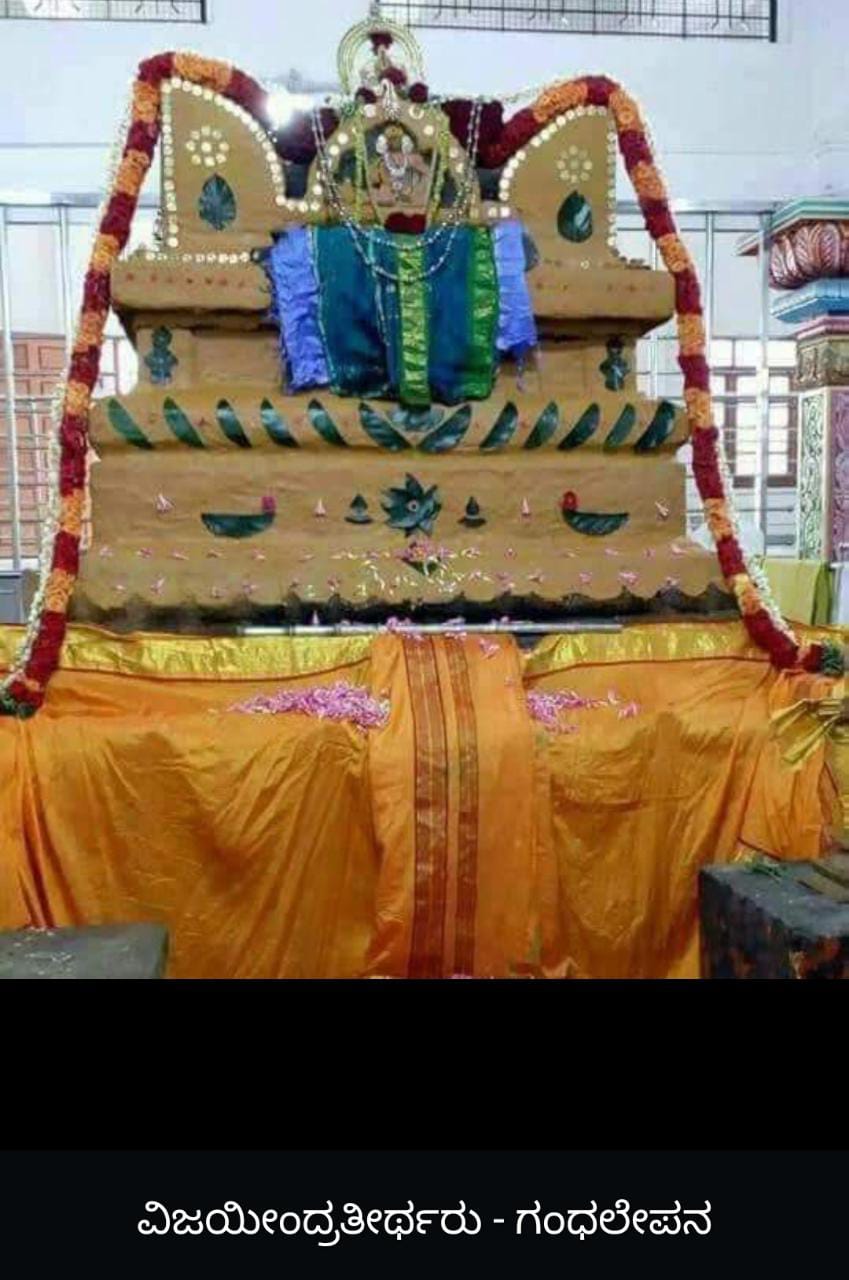
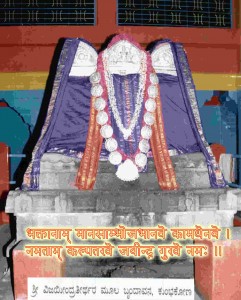
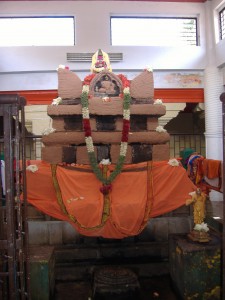
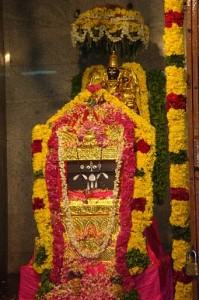
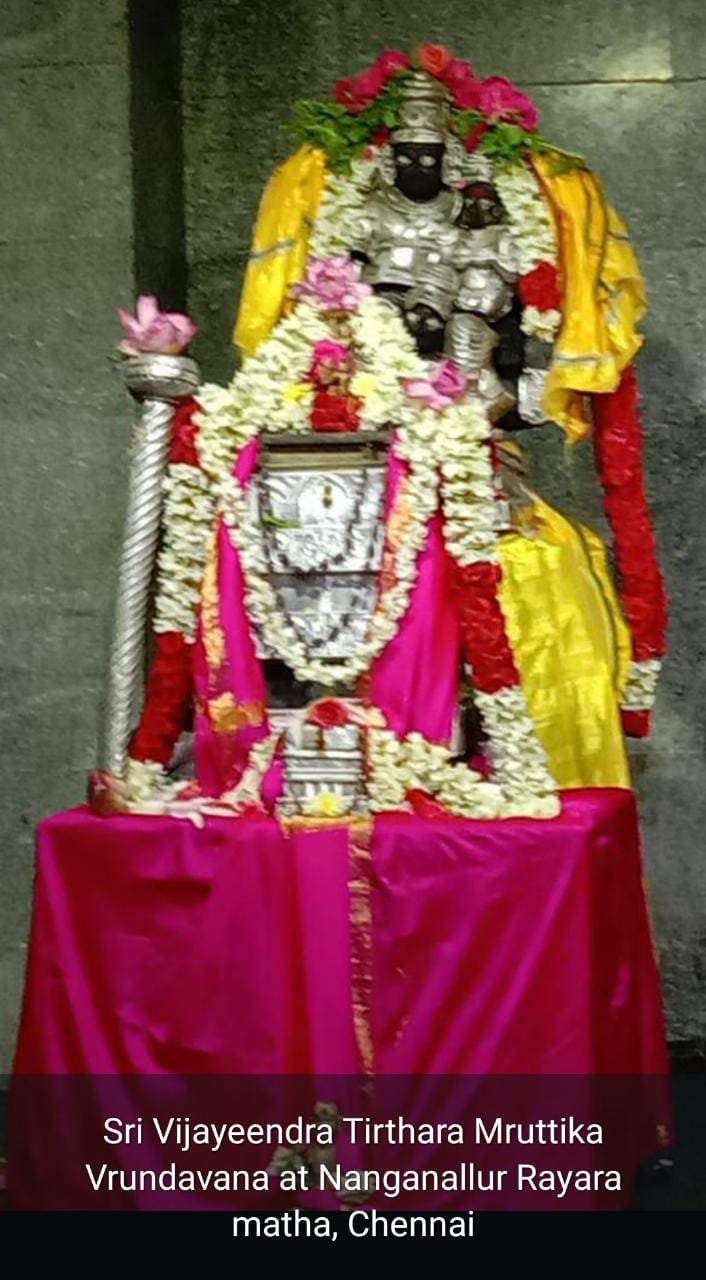
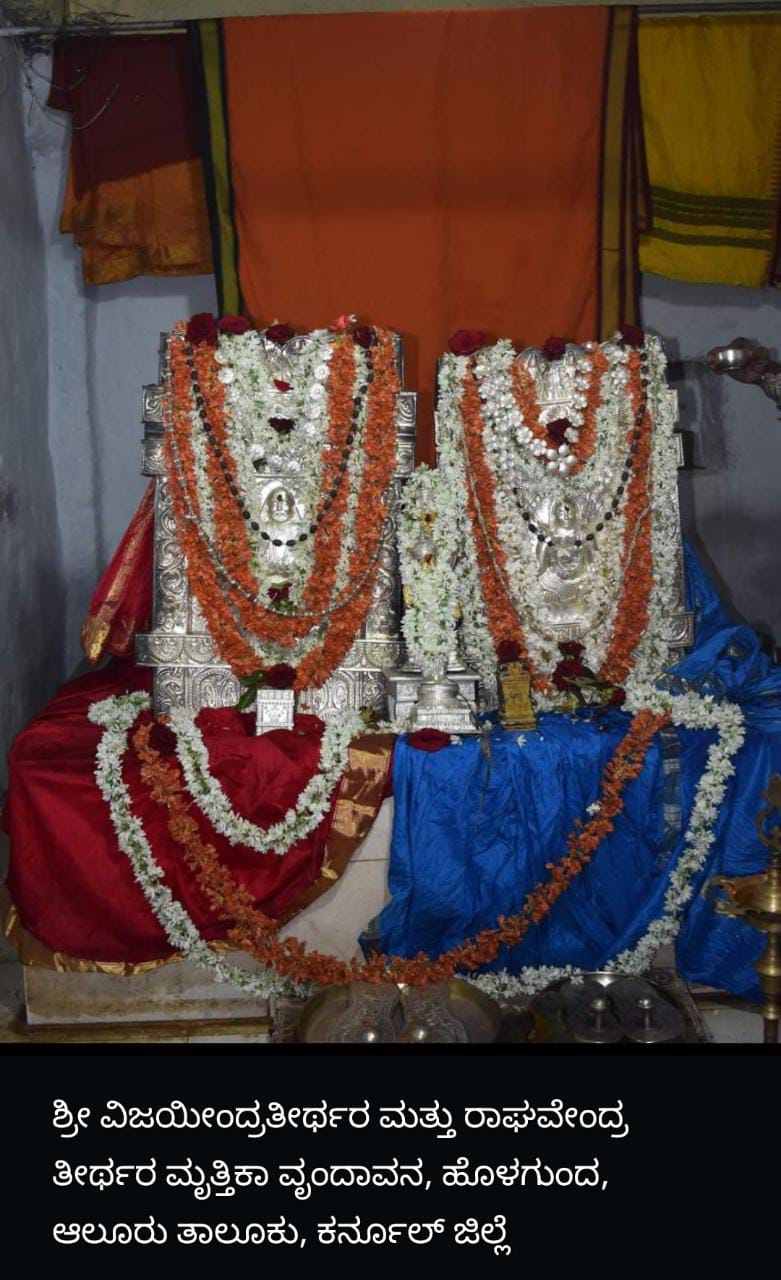
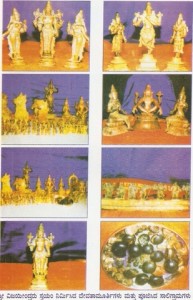
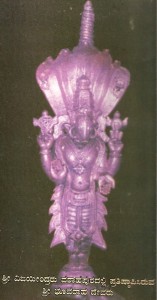

Namaskar. The Bhoovaraha image given above is the presiding deity in the Sree Varaha temple in VARAPUZHA (VARAHAPURA), ERNAKULAM DISTRICT, KERALA. It is believed that Sreemad Vijayendra Teertha Swamiji had done the Pratishtha about 400 years back. Could any body give more details such as date, Tithi, Paksha etc of this Prathishtha, at Varapuzha ? It is also understood that, previously there was Ugra Nrisimha Moorthy in this temple. Swamiji took that vigraha and consecrated at MULKI (D.K), Karnataka. Any body who knows more details may please provide it to me.
Dr.HAREENDRA SARMA (VARAPUZHA, KERALA) Mob: 0 – 9446012167